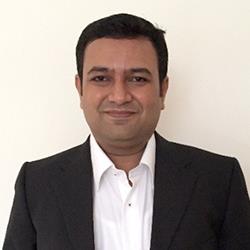Articles
FP&A: Sustainability Practices and Talent Development
- By Bryan Lapidus, FPAC
- Published: 2/22/2021

Last year, AFP announced the formation of its APAC FP&A Advisory Council (FPAAC). The networking and advisory group meets three to four times a year to discuss best practices, common challenges and innovative initiatives in the Asia-Pacific region. We’ll be profiling individual members of the council every month. This month we spoke with Keyur Shah, senior finance director, FP&A COE, APAC, Johnson & Johnson.
Lapidus: I notice you're wearing your Johnson & Johnson shirt very proudly; what about Johnson & Johnson inspires pride among their employees?
Shah: One of the most important things about Johnson & Johnson is our credo, which says that our first responsibility is toward our customers, the patients, mothers and fathers to whom we sell. Our second responsibility is toward our employees, third is toward the community in which we work, and fourth is toward the stockholders. What this says is that if we do well with the first three constituents, then the shareholders return will automatically be generated.
How did you get into FP&A as a line of work?
I started my career with Johnson & Johnson back in 2000 in India. I was always passionate about numbers. One of my first roles was in FP&A as a senior analyst; I really enjoyed that role. From there, I rotated into a variety of roles and spent about eight years in India. Then I came to the U.S. where I served for two years at the corporate headquarters heading FP&A as senior manager for medical devices. After that, I worked as commercial finance director and supply chain finance leader. And now I'm heading FP&A COE.
How did you end up in Singapore?
After I completed my work in the U.S., I was given a few options, one of which was a unique role in Singapore where I would be finance director over a cluster of four markets. I was successful in the interview and chose to come to Singapore.
What led you to join AFP's Asia Pacific Advisory Council?
I'm leading FP&A for Johnson & Johnson and am shaping the skill sets for this department, which means I need to be aware of best practices and trends. As a result, I decided to invest some of my time by joining with AFP so I can learn about the key new trends and bring those back to my organization.
How does AFP complement what Johnson & Johnson is already doing?
AFP brings industry expertise in curriculum and training: What are the key trends? What are the key skillsets? How do you deepen somebody's analytical skillset? How are you going to deepen FP&A skillsets, digital skill sets of finance professionals? We can always nominate a few people to participate in those trainings. As a result, it's going to be a win-win scenario for us to have more trained professionals on certain analytical skill sets.
See how becoming certified in FP&A can advance your career and validate your unique skillset. Download the FPAC brochure here.
When you think about the work the council has ahead of it, what would you like to see the council accomplish in the next year? And how would you like to contribute to that?
First, we have to think about what the future trends are, which are happening, and where the function is going to be heading. That's something we should brainstorm a little bit.
Second, how are we going to enable and deepen some of the problem-solving skills in our teams. What are we seeing from an FP&A point of view? How can this council share best practices with a wider audience, perhaps create a forum where industries can share with each other things like what platforms they are using, what are some of their frameworks on talent development, on skill development, where they see the value, and how FP&A is changing?
With Covid, we have seen that we were doing the planning every week, right? And the scenarios change pretty significantly, so agility is quite important. It would be good to know how some of the other players are managing the situation.
Earlier, you mentioned how J&J thinks prioritizes various stakeholders, with shareholders being fourth. How does the capital allocation reflect that?
In terms of discounted ROIs or cost of capital, we have differentiated discounted ROI based on the risk premium of the project and in the market that we work. Based on the sector in which we are working, as well as the markets it serves, there is a cost of capital that is adjusted.
For example, we might invest capital into sustainable energy. If our normal project ROI requirement is payback in three years, for this kind of project we allow a bit longer payback, let's say, five years. By differentiating the ROI requirement for sustainability purposes, we are encouraging investment to help the planet.
Separately, we also separately carve out a certain budget into purely community and charitable activities.
Who does that? Is the head of FP&A involved? Or is that the CFO and the CEO?
It will certainly go to the CFO, and the recommendation will go from the head of FP&A corporate function to the global leadership. Our philosophy is very simple: We want to grow our sales faster than the market and grow profitability faster than sales, and as finance, we consider ourselves business leaders with financial expertise versus finance leaders. That's our philosophy. So that's one axis, to be a business leader with financial expertise, and the second part is how we are going to develop our talent faster than our competition. That's how we think about it.
What does that look like? How are you developing talent in FP&A?
In terms of developing talent in FP&A, we have a very robust onboarding plan for all the new employees. We have orientations they have to go through for the first seven days, 30 days, 60 days, and 90 days. Then, once people are in a team, we encourage them to get a different certification, including an FP&A certification.
We also encourage our people to build digital skills in four brackets. first is automation, second is visualization and storytelling, third component is diagnostic — this entails descriptive skill sets such as how are you going to do a deep dive analysis of what happened? why did it happen? and trying to create insight and analysis from that. And the fourth component, what we call “advanced analysis,” is more about scenario planning and also a certain statistical regression modeling.
We want to play a role of talent incubator. We bring a lot of young talent into our group, develop them and protect them.
Keyur Shah is on the AFP FP&A Task Force, helping to create the educational plan for AFP FinNext Asia.
Copyright © 2024 Association for Financial Professionals, Inc.
All rights reserved.

